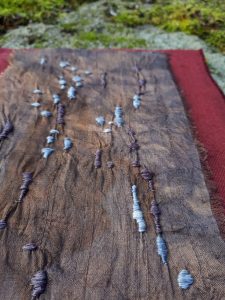We are legion, each and every one of us. Always a ‘we’, and never a ‘me’.
~ Ed Yong, I Contain Multitudes (2016)
We like to believe that we are separate and superior, but we are all entangled.
I am interested in finding the places of connection, the colours, textures and forms that show us our place in the world as animal, mineral, microbial and multiple beings. For a recent series of works, Mineral Bodies, I developed flesh tones using plant dyes and rust. Using stitch, fabric was sculpted around stones, the seams like veins and scars. Everything I make is deliberately tactile, made to be touched, picked up or felt with the fingertips.
I don’t buy materials new, always salvage or swap and work with what I can find. This includes all my fabric and embroidery threads, which I source secondhand. Silk is my favourite fibre – it takes colour and print especially well, and it has a warm, glowing quality. I often use materials that have been discarded or intended for landfill, including stripped wires and plastic. Creating something delicate and precious from overlooked materials, scrap and excess is a way of re-valuing the materials we take for granted.
Rust prints are made in situ, wrapping old fences, mooring rings, barbed wire, corroded nails. I use a variety of techniques to draw out different colours and patterns, including different combinations of tannins and mordants. Plant dyes depend on the season and particular environment I am in. I forage for materials wherever I can find them. Even at this small scale I have to be careful to use sustainable quantities of plant material, not taking too much. I make my own copper and iron mordants from found metals – a mordant fixes colour to fabric, and affects the colour achieved. The beauty of working at this scale is that I can work experimentally with what is available at any given time.
Combining rust printing and natural dyeing gives me subtle shifts in colour and pattern. The process is one of giving in to change, and re-defining failure. I like to allow for uncertainty, working with processes of change within the environment, celebrating change within the human body too. Using rust is using corrosion and decay. Old textiles can eventually rot at the places where the dyes were iron-rich, often used for darker colours, especially black. Natural dyes are variable in their colour fastness, fading at different rates. People used to take this into account and re-dye their clothes periodically. You can try and ignore transience or you can revel in it. Everything goes on changing, just at different timescales.
Sewing is an act of care and kindness. I look for the shared textures, colours and forms between the human and non-human. When I sew, I am paying attention. The splits and seams in bark are like the silvery stretch marks and scars in my skin. The ripples and folds where a tree branch grows from the trunk are like wrists and ankles. One unexpected side effect of making this work is the change in how I feel about my own body. I no longer feel the desire to control or punish it as if it was just an unruly anchor for my mind. Celebrating change – growth, age, disintegration, rot – is a celebration of human mortality too.
I think we need to find ways of undoing the idea of human/nature separation that underpins our destruction of our own habitat and conditions for life. We need ways of seeing our symbiotic selves: enmeshed, not separate to some external ‘nature’.
This is part of ROT, a section of The Learned Pig exploring multispecies creativity through modest tales of collaboration and coexistence amidst world-ending violence and disorder. ROT is conceived and edited by Julia Cavicchi.






